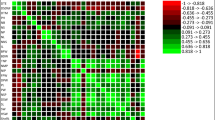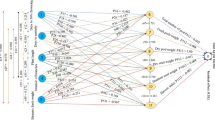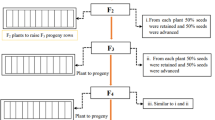Abstract
Selection of superior crosses of groundnut (Arachis hypogaea L.) in early generations would increase the probability of identifying superior lines. The objective of this study was to determine the potential of selecting for physiological traits identified in a yield model [crop growth rate (C), reproductive duration (DR) and partitioning (p)] in segregating populations. Forty populations and nine parental lines were evaluated in replicated trials in 1992 (F2, 1993 (F3) and 1994 (F4) at three locations in Niger. Physiological traits were estimated from final yield and biomass as well as data on flowering and maturity. Regressions from two different parent-offspring generations (F2: F3 and F3: F4) were calculated. The results were compared to determine if early generation performance accurately predicts the performance of cross bulks in later generations. Differences were observed among populations and parents for all traits. Effects of locations were significant for C, p and DR in F2 and F3 but nonsignificant for yield and C in F4. Regression coefficients from F3: F2 were 0.10 ± 0.08 for C, 0.45 ± 0.17 for p, 0.10 ± 0.03 for DR and 0.16 ± 0.03 for pod yield. Based on F3: F4 regression, the coefficients were 0.12 ± 0.23 for C, 0.46 ± 0.17 for p and 0.57 ± 0.17 for yield. Parent-offspring correlations were in most cases similar to the regression values. It was concluded that selection for yield and model components in early generation bulks may inneffective.
Similar content being viewed by others
References
Bandyopadhayay, A., V. Arunachalan & K. Venkajah, 1985. Ef-ficient selection intensity in early generation index selection in groundnut (Arachis hypogaea L.). Theor. Appl. Gen. 71: 300–304.
Bell, M.J., G.C. Wright & G.L. Hammer, 1992. Night temperature affects radiation use efficiency in peanut. Crop Sci. 32: 1329–1335.
Brouwer, J., L.K. Fussel & L. Herrmann, 1993. Soil and crop growth variability in West African semiarid tropics: a possible risk reducing factor for substance farmers. Agriculture, Ecosystems and Environment 45: 229–238.
Coffelt, T.A. & R.O. Hammonds, 1974. Correlation and heritability studies of nine characters in parental and intra-specific cross populations of Arachis hypogaea. Oléagineaux. 29: 23–37.
Duncan, W.G., R.L. McGraw & K.J. Boote, 1978. Physiological aspects of peanut yield improvement. Crop Sci. 18: 1015–1020.
Fernandez, G.C.J. & J.C. Miller, 1985. Estimation of heritability by parent-offspring regression. Theor. Appl. Genet. 53: 650–654.
Frey, K.J. & T. Horner, 1957. Heritability in standard units. Agron. J. 49: 59–62.
Genstat 5 Committee, 1993. Genstat 5 release 3 Reference manual. Oxford Science Publications.
Greenberg, D.C., J.H.Williams & B.J. Ndunguru, 1992. Differences in yield determining processes of groundnut (Arachis hypogaea L.) genotypes in varied drought environments. Ann. Appl. Biol. 120: 557–566.
Halward, T.M., J.C. Wynne & E.J. Monteverde-Penso, 1990. Effectiveness of early generation testing as applied to a recurrent selection program in peanut. Peanut Science 17: 44–47.
Iroume, R.N. & D.A. Knauft, 1987. Heritabilities and correlations for pod yield and leafspot resistance in peanut (Arachis hypogaea L.): Implications for early generation selection. Peanut Science 14: 46–50.
Mohammed, J.J., J.C. Wynne & J.O. Rawlings, 1978. Early generation variability and heritability estimates in crosses of virginia and spanish peanuts. Oleagineux 33: 81–86.
Nigam, S.N., S.L. Dwivedi & R.W. Gibbons, 1991. Groundnut breeding, constraints, achievements and future possibilities. Plant Breeding Abst. 61: 1127–1136.
Wallace, D.H., J.P. Baudoin, J. Beaver, D.P. Coyne, D.E Halseth, P.N. Masaya, H.M. Munger, J.R. Myers, M. Silbernagel, K.S. Yourstone & R.W. Zobel, 1993. Improving efficiency of breeding for higher crop yield. Theor. Appl. Genet. 86: 27–40.
Williams, E. & J.S. Drexler, 1981. A nondestructive method for determining peanut pod maturity. Peanut Science 8: 134–141.
Williams, J.H., 1992. Concepts for the application of crop physiological models to crop breeding. In: S.N. Nigam (Ed.), Groundnut — A Global Perspective: Proceedings of an International Workshop ICRISAT Center, India, 1991, November 25. ICRISAT Patancheru, India, pp. 345–352.
Williams, J.H. & N.P. Saxena, 1991. The use of non-destructive measurement and physiological models of yield determination to investigate differences in seed yield between genotypes of desi' chickpeas (Cicer arietinum). Annu. Appl. Biol. 119: 105–112.
Williams, J.H., R.C. Nageswara Rao, F. Dougbedji & H.S. Talwar, 1996. Radiation interception and modelling as an alternative to destructive samples in crop growth. Ann. Appl. Biol. 129: 152–160.
Wynne, J.C., 1976. Evaluation of early generation testing in peanuts. Peanut Sci. 3: 62–66.
Author information
Authors and Affiliations
Rights and permissions
About this article
Cite this article
Ntare, B. Early generation testing for yield and physiological components in groundnut (Arachis hypogaea L.). Euphytica 107, 141–147 (1999). https://doi.org/10.1023/A:1026441615872
Issue Date:
DOI: https://doi.org/10.1023/A:1026441615872




